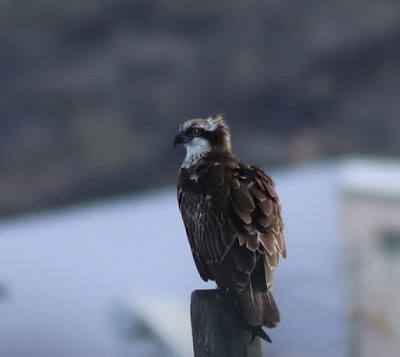The juvenile Osprey marked KL9, first detected on Sep 20, has now been on the island of La Palma for 4 weeks. During this time, I have been regularly checking its movements and have also received regular updates from a local family who observe the Dos Pinos reservoir from their terrace (thanks Íñigo!).
The regional delegation of SEO/Birdlife on Tenerife, and La Palma's environmental authorities have been informed of the bird's presence. It appears there has been at least one previous case of an Osprey (Pandion haliaetus) overwintering on Gran Canaria, rather than continuing its migration to Senegal and Gambia. So, perhaps KL9 will be here for a while!
I found KL9 (whose sex is unknown) resting on a utility pole near the Dos Pinos reservoir this morning, Oct 17.
Osprey KL9 (Pandion haliaetus)
The above photograph was taken from a distance, and I was careful not to disturb the bird by trying to get a better shot. Instead, I headed for the reservoir to await arrival of the young Osprey. The bird soon appeared as expected, beginning its activity with an exploratory flight over the water.
Without attempting to fish it then spent a few minutes resting on the bank of the reservoir. I had my tripod set up this time, hoping to improve on my previous photographs. The Osprey took flight again, and after briefly surveying the water, dived towards its prey:
The following shots were all taken with a 400mm lens and a fairly high ISO 400, to get a fast shutter speed. The pictures are all heavily cropped, but are probably at the limit of what my gear can achieve, given the distance from the subject (c 200m).
Osprey KL9 making off with its catch
It took the bird less than 2 minutes to catch its first meal of the day, after only one dive...a 100% success rate.




















